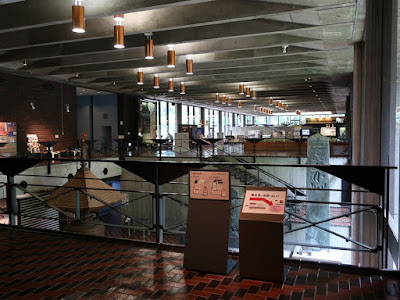This huge museum focuses on the lives and culture in Saitama area.
It is located in a huge park which was a ground of Hikawa Shrine.
In the folklore room, there are many exhibits about fishing despite Saitama is an inland prefecture. There are few full-time fishermen. I think that farmers catch fishes to eat and to enjoy fishing itself.
There is a large experience-based learning area, so this place is also good for children.
The photography was allowed in the limited area when I visited, however, we can take photos in the permanent exhibition area now (some exceptions).
Entrance
Entrance hall
埼玉の人々の暮らしと文化をテーマにした博物館。県立らしく巨大で、展示品は国宝を含めて豊富だ。野球場もある巨大な大宮公園の中にあるが、もともとは武蔵一宮・氷川神社の境内だったようだ。
民俗展示室に様々な漁の道具がたくさん展示されていた。内陸なので、専業漁師は少なく、農民が、釣ることと食べることを楽しみに漁をしていたのだと思う。
ものづくりなどの体験スペースも充実しており、家族で楽しめそう。
私が訪問した時は、古代と民俗の展示室は撮影可、中世、近世の展示室は撮影不可であったが、現在は、全ての常設展示室内の撮影が可能になっている(一部、撮影禁止の展示品あり)。
Folklore Room、民俗展示室
It says “People's livelihood, belief which supported people’s minds, festivals and rituals are shown here.” The subtitle of this room is “Life with water”.
「人々が生活の糧を得るための生業や、心の支えとなっている信仰、さらには祭や行事・儀礼などを紹介」とある。
「水と暮らし」というサブテーマが付いており、漁業に関する展示品が多い。
Life in the city area: model of Kawagoe street
都市のくらしと住まい:川越の模型
Life in agricultural area: it says, “The house had a large garden for farming work. It was surrounded with homestead woodland and hedges to protect from stormy wind.”
里のくらしと住まい:埼玉県東部の台地や低地のすまいは、作業用の庭を広く取り、防風のために低い軒で、屋敷林や生け垣に囲まれていた。行田の民家。
Hill in Hiki area、比企の丘陵
Life in mountainous area: people made flat space and built a house.
山のくらしと住まい:山腹に石垣を築いて作った平地に建てた。秩父地方。
Mountain village in Chichibu area
秩父地方の山の村
Farmers’ lives、農家の暮らし
囲炉裏は、家族の共同の象徴で、「熱は煮炊きや暖房、乾燥に、光は照明に、煙は食品をいぶし、草屋根の虫除けに、灰は肥料や洗剤代わりに用いられるなど、多面的な機能を特徴としています」とある。七輪など用途を限った器具では、用途外のエネルギーが無駄になるらしい。
Eating at an earthen floor、土間で食事
Lunch break while rice planting; they brought bowls and plates from their house. Maybe it was too hot.
家族で食事。田植えの畦での食事。鴻巣市。弁当箱ではなくてご飯茶碗と皿を持ち出している。暑そうなところで食ってるわ。
Water supply、水の利用
People enshrined to the god of a well, and prayed for stable water supply and plague prevention. 井戸神様を祀る
Rite for rain: there were several ways such as going to a sacred place to take water, making a snake or dragon shaped idol or offering a lion dance.
雨乞いのコーナー。雨乞いは、「①聖地へ水をもらいに行く、②蛇や龍の作り物をする、③池や川の水をさらう、④獅子舞を奉納する」などの方法で行ったという。
Great straw snake which is 36 meter long and 3 tons.
藁で、36m、3tonの大蛇を作る
Fishing in inland、内陸部の漁業
The fishing skills: “Saitama does not open to any sea. --- There were some full-time fishery workers but many other fished in small for their own table or for cash income to make up the living”, it says. But I am sure they enjoyed fishing itself. Many fishing tools are exhibited, such as net, rod, or harpoon fishing.漁の知恵: 埼玉県は海に面していないので、専業漁師は限られ、日々の暮らしの合間に、自家消費用として、また、ささやかな現金収入を得るために魚を捕る人が多かったという。と書かれているが、魚釣りを楽しんでいたとしか思えないような、網に竿、銛など様々な工夫された手作りっぽい漁具がある。
Searching for fishes、箱めがねを使った漁(飯能市)
Fishing rod for mountain streams、渓流釣り用の竿
Tools for fishing ayu sweetfish in
mountain streams.
鮎釣りの道具
Fishing ayu sweetfish with a live decoy、鮎の友釣り(秩父)
Trap which was set in a river.
オキバリ。川に流し、餌で魚を釣る。
Fishing tools: Farmers cultivated fishes in reservoirs. They drained water sometimes and got carps, catfishes and eels. An eel is a very expensive fish in Japan.
漁具:農業用のため池は魚を放って養魚池としても使い、水を抜いた時、或いは水が無くなった時は、コイ、ナマズ、ウナギなどを捕まえた。
Fishing tools at the downstream where the width of the river is wide.
荒川下流の漁。川幅が広いので、網や仕掛けを使った漁が行われている。
Traps for catching fishes “Uke”、様々な筌
For yamame fish in a mountain stream、ヤマメを狙う
ウナギを狙う。どの筌にも魚が逃げないようカエシがつけられていると。
For carps、フナやコイを狙う竪型の筌
Fishes were kept in these baskets、捕った魚の保管
Containers to carry fishes、魚を運ぶ
“Pleasure of Eating”: “Fishes were cooked for the people’s daily meals, and also for the special occasions of their celebrations or community gatherings.
Fries and loaches were important protein source to go through the hard farm work of summer.
Carps were served for happy occasions or special treats for guests. They were also gifts to pregnant women because of richness in nutrients.
Catfishes and eels became famous local products. The people also asked brokers or eating houses to buy the catch for the living cash income.”
そして、調理して食べる。ポスターに「食べる楽しみ」と書かれている。
「---捕った魚は、日々の楽しみとして、また、地域の集りや人生の節目を彩る料理として食卓に並びました。ドジョウや雑魚は夏を乗り越えるための貴重なタンパク源であり、コイは寄合や祝い事のご馳走、---。ナマズやウナギのように地域の名物となった魚もあります。多くとれた際には仲買人や料理屋に買い取ってもらい、現金収入を得ることもありました。」
生命力が強く、栄養価が高いコイは、妊娠した女性へのお見舞いなど贈答品になったという。
Brewing sake (alcohol)、酒造り
Tools to manufacture sake、酒造の道具
Reference (many equipment、沢山の道具が展示されています):Kiku-Masamune Sake Brewing Museum 菊正宗酒造記念館
People offer sake to the god and drink it with the god. People pray for good crop and appreciate harvest in these events.
The brewer served sake to the lord and others in Umemiya Shrine festival at Sayama.
「神に供えた酒を神とともにいただき、人と神が交流する。こうした行事は豊作の祈願や収穫への感謝を示していた。
梅宮神社(狭山市)の祭りでは、氏子から選ばれた杜氏役が、領主役に酒を振る舞う」
In Inohana festival at Chichibu, men sprinkle ama-sake in order to drive epidemic away.
猪鼻(秩父市)の祭では、甘酒を掛け合い、疫病を退散させる
Photo of Ema wooden board which offered to the shrine for asking successful brewing.
Indigo dying、藍染め
Upstream of the Tone River is a good place for Indigo plant cultivation and cotton weaving manufacturing. Indigo dying flourished.利根川沿岸の土壌が藍栽培に適しており、木綿生地の生産も行われたことから、藍染めも盛んであった。
Ema board (replica): people offered this to the temple in Kumagaya. They asked for success and improvement of their technology.
熊谷市藍染堂の藍染絵馬の複製。技術の向上と商売の繁盛を願って奉納した。
Samples of indigo dying、藍染の柄見本
Washi (Japanese paper)、和紙作り
Material and manufacturing process in the Edo and Meiji period.原材料と江戸、明治の製造工程
Washi products from various places in Japan; these are very durable.
美濃、浜田と埼玉・小川町の和紙の製品
Making washi paper is hard work、厳しい仕事だ
Ancient era、古代の展示室
People who lived on hunting, fishing, and gathering prayed for a big catch by a magical way. They also prayed for birth and health. Clay dolls and stone polls are exhibited.
縄文人は、まじないの力をかりて、食糧が捕れることを祈り、生命の誕生と維持を願ったという。土偶や石棒などが展示されている。
Accessories、アクセサリー
Medieval era、中世の展示
Stone monuments (replica); I wonder how people cut out these thin and large stone.巨大な石碑の展示。レプリカであるが、こんな大きくて薄い石を良く切り出したものだ。
Experience-based learning area、体験のコーナー
You can wear ancient clothes and take
photos.
服を借りて撮影!
Omiya park、大宮公園
The museum is in huge Omiya park.
博物館は広大な大宮公園内にある
Gate of Hikawa Shrine; Omiya park was the ground of this shrine.
かつては氷川神社の境内だった。
Hall for offering a dance (front) and a main hall (behind)
舞殿(手前)と本殿(奥)
Reference: Bonsai museum, plus train museum in Omiya、盆栽美術館と鉄博
The Omiya Bonsai Art Museum, Saitama 大宮盆栽美術館
Seven funs(楽fun)were found. Visited in June, 2019
Website: https://saitama-rekimin.spec.ed.jp/English
https://saitama-rekimin.spec.ed.jp/ (Much info but in Japanese)
accessed in June, 2020
Previous post (Museum in the same prefecture):
Warabi history and folklore museum 蕨市立歴史民俗資料館
Next post (Museum in the same city):
Iwatsuki Saitama Local History Museum さいたま市立岩槻郷土資料館




















































Comments
Post a Comment